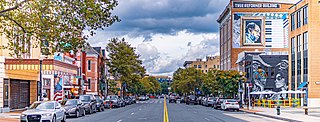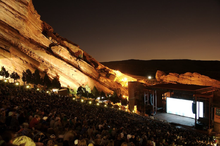Rock is a broad genre of popular music that originated as "rock and roll" in the United States in the late 1940s and early 1950s, developing into a range of different styles from the mid-1960s, particularly in the United States and the United Kingdom. It has its roots in rock and roll, a style that drew directly from the genres of blues, rhythm and blues, and country music. Rock also drew strongly from genres such as electric blues and folk, and incorporated influences from jazz and other musical styles. For instrumentation, rock is typically centered on the electric guitar, usually as part of a rock group with electric bass guitar, drums, and one or more singers. Usually, rock is song-based music with a 4
4 time signature and utilizing a verse–chorus form, but the genre has become extremely diverse. Like pop music, lyrics often stress romantic love but also address a wide variety of other themes that are frequently social or political. Rock was the most popular genre of music in the U.S. and much of the Western world from the 1950s to the 2010s.

Grunge is an alternative rock genre and subculture which emerged during the mid-1980s in the U.S. state of Washington, particularly in Seattle and nearby towns. Grunge fuses elements of punk rock and heavy metal. The genre featured the distorted electric guitar sound used in both genres, although some bands performed with more emphasis on one or the other. Like these genres, grunge typically uses electric guitar, bass guitar, drums and vocals. Grunge also incorporates influences from indie rock bands such as Sonic Youth. Lyrics are typically angst-filled and introspective, often addressing themes such as social alienation, self-doubt, abuse, neglect, betrayal, social and emotional isolation, addiction, psychological trauma and a desire for freedom.

The U.S. state of Washington has been home to many popular musicians and several major hotbeds of musical innovation throughout its history. The largest city in the state, Seattle, is known for being the birthplace of grunge as well as a major contributor to the evolution of punk rock, indie music, folk, and hip hop. Nearby Tacoma and Olympia have also been centers of influence on popular music.
The music of Finland can be roughly divided into folk music, classical and contemporary art music, and contemporary popular music.

Germany claims some of the most renowned composers, singers, producers and performers of the world. Germany is the largest music market in Europe, and third largest in the world.

Washington, D.C., has been home to many prominent musicians and is particularly known for the musical genres of Jazz, Rhythm & Blues, bluegrass, punk rock and its locally-developed descendants hardcore and emo, and a local funk genre called go-go. The first major musical figure from District of Columbia was John Philip Sousa, a military brass band composer. Later figures include jazz musicians, such as Duke Ellington, Charlie Rouse, Buck Hill, Ron Holloway, Davey Yarborough, Michael A. Thomas, Butch Warren, and DeAndrey Howard; soul musicians, including Billy Stewart, The Unifics, The Moments, Ray, Goodman & Brown, Van McCoy, The Presidents, The Choice Four, Vernon Burch, guitarist Charles Pitts, and Sir Joe Quarterman & Free Soul.

Illinois, including Chicago has a wide musical heritage. Chicago is most famously associated with the development of electric blues music. Chicago was also a center of development for early jazz and later for house music, and includes a vibrant hip hop scene and R&B. Chicago also has a thriving rock scene that spans the breadth of the rock genre, from huge stadium-filling arena-rock bands to small local indie bands. Chicago has had a significant historical impact on the development of many rock subgenres including power pop, punk rock, indie rock, emo rock, pop punk, and alternative rock.

American rock has its roots from 1940s and 1950s rock and roll, rhythm and blues, and country music, and also draws from folk music, jazz, blues, and classical music. American rock music was further influenced by the British Invasion of the American pop charts from 1964 and resulted in the development of psychedelic rock.
The American state of Colorado has many music scenes and venues, especially in the larger cities like Denver and Colorado Springs.

American popular music is popular music produced in the United States and is a part of American pop culture. Distinctive styles of American popular music emerged early in the 19th century, and in the 20th century the American music industry developed a series of new forms of music, using elements of blues and other genres. These popular styles included country, R&B, jazz and rock. The 1960s and 1970s saw a number of important changes in American popular music, including the development of a number of new styles, such as heavy metal, punk, soul, and hip hop.
Seattle is the largest city in the U.S. state of Washington and has long played a major role in the state's musical culture, popularizing genres of alternative rock such as grunge and being the origin of major bands like Alice in Chains, Soundgarden, Pearl Jam, Screaming Trees, Mudhoney, Foo Fighters, and, most notably, Nirvana. The city and surrounding metropolitan area remains home to several influential artists, bands, labels, and venues, and is home to several symphony orchestras; and world-class choral, ballet and opera companies, as well as amateur orchestras and big-band era ensembles.
A number of overlapping punk rock subgenres have developed since the emergence of punk rock in the mid-1970s. Even though punk genres at times are difficult to segregate, they usually show differing characteristics in overall structures, instrumental and vocal styles, and tempo. However, sometimes a particular trait is common in several genres, and thus punk genres are normally grouped by a combination of traits.
Colorado Music Buzz Magazine focuses on covering the Colorado music scene, particularly with a particular emphasis on mid-level bands and artists that have the potential for broader recognition. Founded in 2005 in Parker, Colorado, by Keith Schneider and F. Eric Fletcher, the magazine became a key platform for showcasing emerging talent.

Canadian music genres identifies musical sounds as belonging to a particular category and type of music that can be distinguished from other types of music made by Canadians. The music of Canada has reflected the multi-cultural influences that have shaped the country. First Nations people, the French, the British, the Americans and many others nationalities have all made unique contributions to the musical genres of Canada. During the swing boom of the late 1930s and early 1940s, Canada produced such notable bandleaders as Ellis McLintock, Bert Niosi, Jimmy Davidson, and Mart Kenney. In the 1940s, Bert Niosi and Oscar Peterson became widely known. Canada has also produced a number of respected classical music ensembles, including the Montreal Symphony Orchestra and the Toronto Symphony Orchestra. Canadian rock describes a wide and diverse variety of music produced by Canadians, with the most notable Canadian rock band being Rush, who currently place fifth behind The Beatles, The Rolling Stones, KISS and Aerosmith for the most consecutive gold and platinum albums by a rock band. The Canadian hip hop scene was first established in the 1980s. Some of the most well known Canadian rappers and hip-hop artists include Drake and Maestro Fresh-Wes.
This is a list of lists of musicians.
Music of the Pacific Northwest encompasses many musical styles from prehistory to the modern Pacific Northwest.









